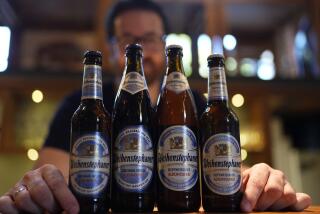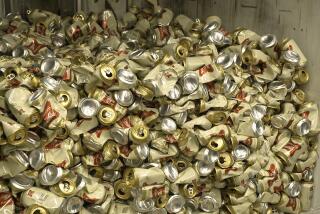Lowenbrau Hopes Its Old Recipe Will Be a New Formula for Success
It was one of the most popular imported products in the United States, with a distinctly German bent and a commercial jingle so popular that it was parodied on âSaturday Night Live.â
But the formula for the product was changed in the mid-1970s when its U.S. distribution rights were sold to an American company, and it was repositioned to compete against more affordable domestic brands. Since then, it has all but fallen off the map.
Now, like the Volkswagen Beetle before it, this once-popular German import--Lowenbrau beer--hopes to stage a comeback by returning to its roots. It will once again become an imported beer, made using its original Munich formula.
Beginning today, Labatt USA takes over the U.S. rights to Lowenbrau from Miller Brewing Co., which had distributed the brand domestically for more than two decades. Officials at Lowenbrau AG Munich, which licenses its beer in 12 other countries, were not pleased with Millerâs switch in recipes but were contractually powerless to do anything more than encourage the company to change it back.
But they so believe in the German formula that they are willing to risk a potentially staggering downturn in sales.
Because Lowenbrau will be positioned to sell alongside other imports such as Heineken and Beckâs--and because the German formula costs more to produce--the price of a six-pack will jump to between $5.99 and $6.99, 40% to 50% more than what it sells for now.
As a result, Labatt expects sales to drop dramatically--an estimated 50% to 60%--from the approximately 450,000 barrels Miller sold last year. Itâs a trade-off that Labatt and Lowenbrau are willing to make in pursuit of long-term growth.
âWe donât anticipate taking the business over from Miller and growing it in the first year,â said Tom Cardella, Labattâs marketing vice president. âWe have built a realistic plan where we are looking at seeing about half the business Miller did.â
At its peak under Miller, Lowenbrau sold 1.2 million barrels nationally, less than 1% of the total beer market. When the German-formula beer was first sold, back in the 1970s, sales were about 400,000 barrels a year.
Labatt officials said they donât expect the ânewâ Lowenbrau, which should be on store shelves within a week, to reach the sales levels it had under Miller for quite some time.
In the meantime, Lowenbrau and Labatt face some interesting marketing challenges.
For starters, Millerâs version of Lowenbrau is still on shelves and will remain there until existing stock sells out. Beer drinkers will be able to tell the difference by the labeling. The ânewâ Lowenbrau says âimportedâ on the neck of the bottle and âOriginal Munich Formulaâ on the label.
That puts the ânewâ brand in the extremely awkward position of competing with the old, lower-priced domestic of the same name.
âThis is not very common,â said Greg Prince, executive editor of Beverage World magazine. âIn a lot of cases you would be talking about ânew and improved,â where in this case you would be talking âold and improved.â â
To spread the word about the new Lowenbrau, Labatt plans to roll out a billboard campaign next month as well as radio spots in selected areas. That will be followed by a multimillion-dollar television, radio and print campaign early next year created by New York advertising firm Ammirati, Puris & Lintas.
Labatt executives have been tight-lipped about the new campaign, but one did confirm that the iconic âLet it be Lowenbrauâ jingle (âHereâs to good friends, tonight is kind of special . . . â) will figure prominently, perhaps with new lyrics.
âWe are planning a bit of a surprise,â Cardella said. âIt makes a lot of sense to try and utilize a nostalgic strategy. The real core element [of the advertising campaign] is the restoring of a classic.â
The ads for Lowenbrau premium lager and premium dark will appear in about 25 markets, including Los Angeles, New York, San Francisco, Chicago, Miami, Boston, Atlanta, Denver and Dallas. According to Labatt, these large urban markets account for about 70% of imported-beer sales in the U.S.
Miller stopped promoting the beer after spending only $250,000 on advertising in 1997--the year the Labatt deal was sealed.
âWhen weâve done our testing, the Lowenbrau name is still a very, very strong name,â said Nick Gagliardi, Labatt USAâs vice president and general manager for 13 Western states. âPeople recognize the name and they recognize the jingle. Even though Miller repositioned and reformulated it, people still associate it with being a German beer, and we see that as an opportunity to put the heritage back into the beer.â
The Los Angeles market is particularly important to Labatt, said David van Wees, West Coast field marketing director at Labattâs regional offices in Foothill Ranch.
âL.A. is just a critical marketplace in the United States in the beer industry, especially when it comes to imported beers,â van Wees said. âThey are growing faster in L.A. than other places, and what happens here influences the other areas.â
Norwalk, Conn.-based Labatt USA is a joint venture of Labatt Breweries of Canada and CCM of Mexico. Labattâs portfolio of specialty beers includes Mexicoâs Dos Equis and, in the U.S., Rolling Rock.
Miller had produced Lowenbrau at several of its U.S. breweries, including Milwaukee and Irwindale. The ânewâ Lowenbrau will be brewed in Canada in accordance with Germanyâs beer purity law, known as Reinheitsgebot. The centuries-old edict requires that only the finest-quality malt, hops, yeast and water be used in the brewing process, said Karl-Werner Adler, director of international brewing for Lowenbrau.
The yeast will be shipped from Germany, and production of the beer will be closely monitored by Adler and his team of inspectors. The result, Labatt said, will be a âbolder, stronger, more European taste, with more hops and a very clean finish.â
âItâs a real delicate balance to get a flavorful beer,â said Adler, who traveled from Germany for the relaunch of the original Lowenbrau in the U.S. âI was at Miller several times pushing them to change to the original recipe, but I never could. For them, it was an American beer brewed their way and they didnât want to go away from that. I wonât say the beer was a bad beer . . . it was a good American beer. But it was not our beer.â
Labatt officials admit that changing the formula will cost them loyal Lowenbrau drinkers who are satisfied with the Americanized version and the lower price. But they are confident they will build a new, better core customer: beer-drinking males 25 to 35 years old who occasionally âtrade upâ and buy a European import.
It will be a steep challenge because the import market is crowded with entrenched, strong brands, said Gary Hemphill of Beverage Marketing Corp. in New York.
âItâs kind of a double-edged sword,â he said. âThe fastest-growing brands are imports, but itâs also an extremely competitive marketplace right now.â
More to Read
Inside the business of entertainment
The Wide Shot brings you news, analysis and insights on everything from streaming wars to production â and what it all means for the future.
You may occasionally receive promotional content from the Los Angeles Times.










